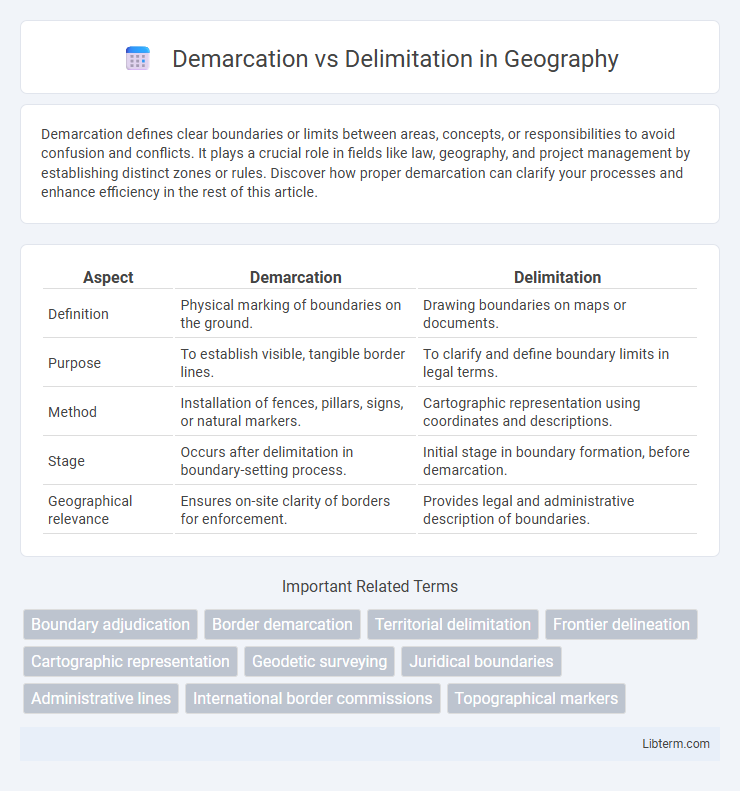Demarcation defines clear boundaries or limits between areas, concepts, or responsibilities to avoid confusion and conflicts. It plays a crucial role in fields like law, geography, and project management by establishing distinct zones or rules. Discover how proper demarcation can clarify your processes and enhance efficiency in the rest of this article.
Table of Comparison
| Aspect | Demarcation | Delimitation |
|---|---|---|
| Definition | Physical marking of boundaries on the ground. | Drawing boundaries on maps or documents. |
| Purpose | To establish visible, tangible border lines. | To clarify and define boundary limits in legal terms. |
| Method | Installation of fences, pillars, signs, or natural markers. | Cartographic representation using coordinates and descriptions. |
| Stage | Occurs after delimitation in boundary-setting process. | Initial stage in boundary formation, before demarcation. |
| Geographical relevance | Ensures on-site clarity of borders for enforcement. | Provides legal and administrative description of boundaries. |
Introduction to Demarcation and Delimitation
Demarcation refers to the physical marking of boundaries on the ground, using visible symbols like fences, pillars, or signs to identify the limits between territories. Delimitation involves the legal and technical process of defining boundary lines on maps or documents, establishing agreed-upon limits before physical markings are made. These processes are essential in resolving territorial disputes and ensuring clear jurisdictional management between neighboring states or regions.
Defining Demarcation
Demarcation involves the physical marking of boundaries on the ground between two or more parties, often using markers, fences, or walls to clearly indicate territorial limits. It serves as a concrete, visible representation of agreed or disputed borders, ensuring clarity and reducing conflicts by providing a tangible reference. The process is critical in international diplomacy and land management to enforce treaties or land ownership rights.
Understanding Delimitation
Delimitation involves the precise drawing of boundaries on maps based on agreed coordinates, serving as a technical and cartographic process that establishes the framework for territorial claims. This step is crucial in international boundary-making as it translates political agreements into a visual and measurable form, reducing ambiguity between neighboring states. Understanding delimitation helps to ensure clarity in jurisdiction and resource management, often preceding the physical demarcation of borders on the ground.
Key Differences Between Demarcation and Delimitation
Demarcation refers to the physical marking or boundary setting between two areas, often using markers, fences, or posts, while delimitation involves the formal establishment or definition of boundary lines on maps or legal documents. Demarcation is a tangible process conducted on the ground, whereas delimitation is a conceptual or administrative task completed through negotiation or legal agreements. The key difference lies in delimitation defining the boundary's coordinates, and demarcation implementing those coordinates physically.
Historical Perspectives on Boundary Creation
Historical perspectives on boundary creation reveal demarcation as the process of physically marking borders through walls, fences, or pillars, often following colonial-era treaties or wars that defined territorial claims. Delimitation involves legally defining boundaries on maps based on diplomatic agreements or negotiations, reflecting attempts to clarify jurisdiction without immediate physical manifestation. These methods combined shaped modern political geography by translating abstract territorial claims into recognized and enforceable limits.
Legal Implications of Demarcation and Delimitation
Demarcation refers to the physical marking of boundaries on the ground, often involving the placement of boundary markers or fences, which legally establishes the exact limits of territorial claims and reduces disputes. Delimitation, by contrast, is the legal process of defining boundaries on maps or documents, forming the basis for treaty negotiations and international agreements. The legal implications of demarcation hinge on enforceability and recognition of borders, while delimitation shapes jurisdictional authority and sovereign rights over territories.
Demarcation and Delimitation in International Relations
Demarcation in international relations refers to the physical marking of boundaries on the ground to clearly define territorial limits between states, often involving joint surveys and installation of boundary markers. Delimitation involves the legal process of formally defining the boundary lines on maps through diplomatic negotiations and treaties. Effective demarcation ensures the enforcement of delimitation agreements, reducing boundary disputes and enhancing state sovereignty.
Case Studies: Global Examples
Demarcation involves physically marking boundaries, as seen in the India-Bangladesh Land Boundary Agreement where pillars and fencing were installed to define borders. Delimitation refers to legally defining boundaries on maps, exemplified by the Colombia-Panama maritime delimitation where coordinates were agreed upon through international arbitration. Complex disputes like the Israel-Palestine border highlight challenges where demarcation is hindered despite established delimitations under various accords.
Challenges and Controversies in Boundary Setting
Demarcation and delimitation face significant challenges including disputes over territorial sovereignty, varying interpretations of treaties, and the complexity of natural geographic features. Controversies often arise from overlapping claims, inconsistent historical documents, and the influence of political or economic interests, complicating clear boundary establishment. Effective boundary setting requires addressing these conflicts through diplomatic negotiation, international law frameworks, and sometimes third-party mediation.
Conclusion: Importance in Governance and Peace
Demarcation and delimitation are essential processes in defining precise boundaries, directly influencing governance by clarifying territorial jurisdiction and reducing administrative conflicts. Effective boundary demarcation supports peace by preventing disputes and fostering cooperation between neighboring states or communities. Clear and mutually agreed boundaries establish a foundation for sustained stability, security, and development.
Demarcation Infographic

 libterm.com
libterm.com